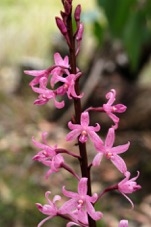The displays of our attractive Rosy Hyacinth Orchid, Dipodium roseum, have been outstanding this summer with the tall flower stems bearing numerous stalked flowers in varying shades of pink appearing throughout the district.
They have even been competing with the invasive Bluebell Creeper, Billardiera heterophylla, as can be seen in the Hyacinth Orchid photograph.

On the other hand, our other species of Hyacinth Orchid, the white Hyacinth Orchid, Dipodium pardalinum, has not been so successful with vey few specimens having been observed.
An Orchid Story
The Large Tongue Orchid, Cryptostylis subulata, is a very rare species in our district, really only known from one location, where it grows in a swampy area of heathy woodland mainly taken over by Prickly Tea-tree, Leptospermum continentale. It is an evergreen orchid with its distinctive leathery green leaves to 15cm long either solitary or in clumps present throughout the year.

The yellowish-green flowers have a large labellum which point downward. The labellum is reddish at the tip and is a feature of the orchid. You need to observe it from underneath to appreciate its beauty.

We sometimes have very good displays of flowers, but this year very few have appeared, although we observed a large quantity of leaves – perhaps the area dried out very quickly after the good spring rains. It was however still very good habitat for a large tiger snake that was moving through the vegetation when we visited the site.
The species is grown in cultivation by orchid growers and two of our members, Lance Breguet and Helen Schofield, have had great success with cultivating the orchid. This year Lance and Helen were thrilled to see the male pollinating wasp, Lissopimpla excels, in action on their flower in Geelong West.

The wasp held its black and white striped abdomen inside the orchid flower next to the tiny column for over 10 minutes. It certainly was making sure that it was ‘mating’ with its ‘female counterpart’. Of course it won’t help Lance’s orchid unless it has cross pollinated the pollinia from another flower. We have been told that the wasp leaves its semen behind in the orchid.
Greenhoods Pterostylis sp. (Part 7)
Following our last article in the October Newsletter we have another species of Greenhood – the Large Sickle Greenhood, Pterostylis falcate, to add to our target of 19 species. We now have four more to feature hopefully this year.
Usually flowering in about November in our district we were thrilled to find this spectacular greenhood flowering in January in a very damp area beside Marshy Creek. It has an extremely large flower curved forward like a sickle and a large protruding labellum.

The species hybridises with the common Nodding Greenhood, P. nutans, to form the rare hybrid orchid, P. x ingens. Obviously we will return later in the year to see if we can locate this orchid – one of our four more to capture!
Summer is usually not a good time for terrestrial orchids but we can’t complain this year. Other species that have been observed flowering are Flying Duck Orchids, Caleana major, Small Duck Orchids, Paracaleana minor, Horned Orchids, Orthoceras strictum, and even a few of the elusive Elbow Orchids, Thynninorchis huntianus.
A little further afield a few of us have observed Black-tongue Caladenias, Caladenia congesta, (Forrest) and the spectacular Ladies Tresses, Spiranthes australis, (Brisbane Ranges). We do have Caladenia congesta on our list but have not found it for a few years – it would be great to find Spiranthes in our district. We have not located Dark-tipped Greenhoods, Pterostylis atrans, this season and we are still hopeful of locating Cinnamon Bells, Gastrodia sesamoides, – has anyone had success?
Remember that photos and descriptions of all our orchids are found in Orchids of the Anglesea District available from Angair.
Margaret MacDonald